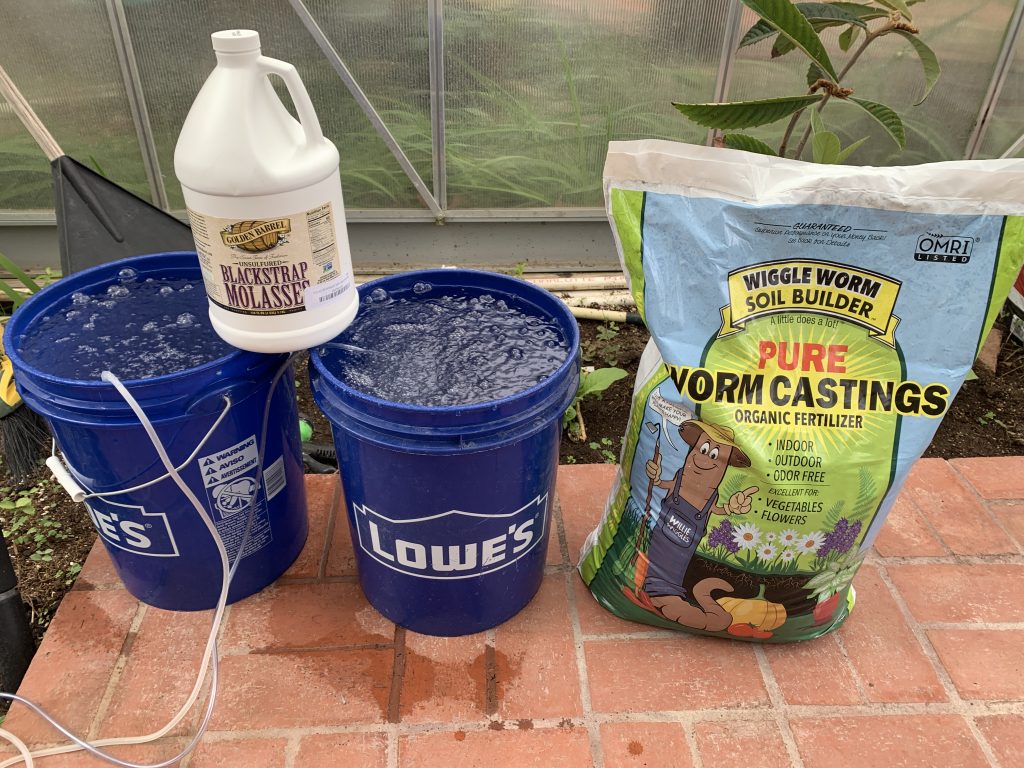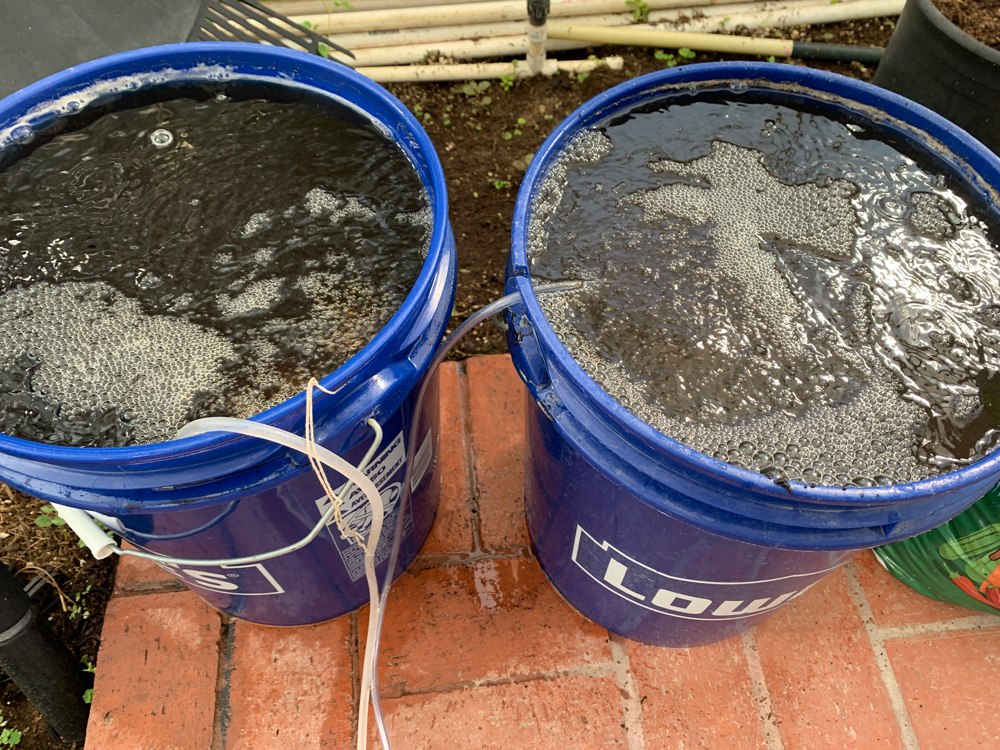Worm Tea, also known as Compost Tea or Bokashi, is a highly effective plant nutrient you can make at home easily. You’ve probably heard of this strange “tea” online or perhaps at a hydroponics store, and wondered what it’s all about. While it’s not a tea that you and I can drink, it’s a special LIVE bacteria formula that plants love! Not only do they love it, it helps them grow noticeably fast, and also acts as a natural organic pesticide. In this guide, I’m going to explain the entire process for brewing your own worm tea, including everything you’ll need as well as brewing equipment.
What is worm tea?
Think of it as Kombucha for plants. It has all of the live bacteria your plants/soil will thrive on, creating the perfect ecosystem for your leafy friends. You simply steep worm castings (worm poop) in water along with sugar (molasses), creating a microbiological environment by adding bacteria, fungi, actinomycetes and protozoa into the soil. Believe it or not, your plant roots communicate with the soil telling it what nutrients it needs. Soil should be very much alive, just like your plants. Think about the forests, believe it or not, all of the plants and trees in the forest communicate with one another. Plants are living creatures with consciousness. There have been numerous studies done to prove this, however more on that in another article!
Benefits of feeding your plants worm tea
Worm tea will out perform any chemical fertilizer out there, increasing plant size and overall yield.
Worm tea is used as an inoculate for potting soil and will suppress airborne pathogenic fungi that can infect sterile potting soil. The organisms in worm tea produce a lot of beneficial nutrients for your plants including hormones, vitamins, nutrients, enzymes, amino acids and minerals.
Plants grown in soil with worm tea are noticeably healthier overall and have a strong root system.
Additionally, this is a safe and effective way of keeping a lot of pests at bay, thus protecting your plants and crops.
What you’ll need to make worm tea

While you can purchase worm tea concentrate, I highly recommend against it! It’s so easy to make your own fresh worm tea, allowing you to provide only the freshest nutrients to your plants. While you may see an improvement in your plants health when using a concentrate, it’s not the same. Making your own fresh tea provides far more live probiotics to your plants and soil, that it only makes sense to make the small investment into brewing your own tea.
Here’s what you need to brew 5 gallons of concentrated worm tea at a time (yields 15 gallons of usable tea — more on that in a bit).
The below list of equipment will allow you to configure the “perfect” brewing setup. Not everything below is required, which we’ll explain what you can omit at the end of this article. I’ll also explain the drawbacks to omitting certain things.
Supplies list for brewing worm tea
- A 5 gallon bucket. You can get these from Lowes or Home Depot. About $3/ea.
- An aquarium aerator. About $10
- Air tubing. About $5
- Air stone. About $2/ea
- Worm castings. You can buy a 30 lb bag on Amazon for about $30.
- Unsulfured Molasses
- Cheese cloth bags
- Boogie water purifier (optional) – $50
Time to setup your equipment
If you purchased the Boogie water purifier, simply connect it to your hose. This is going to filter out all of the nasty stuff in your tap water, including chlorine. Chlorine’s primary job is to kill bacteria, so if you don’t do this, you’re tea will be useless. You can literally safely drink the water that comes out of the Boogie water purifier, as it’ll do a better job at purifying your tap water than your fridge filter does.
OPTIONS AVAILABLE:
- If you decide to skip the water filter, then you can fill your 5 gallon bucket with tap water and let it sit out in the sun for 24 hours. After a day most of the chlorine will have dissipated.
- Another option is to fill your 5 gallon bucket with tap water and place your air stone in the bucket and allow the water to bubble. This will speed up the removal of chlorine allowing it to gas off very quickly. If you do this method, your water will be ready in about 12 hours or less depending upon how much chlorine is in your tap water. 12 hours is generally a safe timeframe, so it’s a good idea to fill the bucket and aerate it the night before you brew. That way, your water will be ready in the morning.
Fill your bucket with water
Let’s assume you are using filtered water, or already removed the chlorine from your water by way of one of the two methods above. Place the air stone in the bottom of the bucket and turn on your aerator. You want to turn it on full speed to ensure a good amount of oxygen is being infused into the water.
Add your ingredients to the water
Recipe for brewing 5 gallons of worm tea:
- 2-3 cups of worm castings
- 2 tablespoons of unsulfured molasses
This recipe will yield 10-15 gallons of worm tea. While this is the traditional recipe, some people will use 3lbs of worm castings to 1/3 cup of molasses in a 5 gallon bucket. You can play with the amounts however you like, however using the traditional recipe above will yield great results.
TIP: Place the worm castings into a cheesecloth bag. This will allow the castings to stay in the bag so that if you decide to put your tea into a sprayer, it won’t clog the nozzle. If you plan on just feeding your plants at the base and not spraying the foliage, then you don’t need the bags.
Now that you have your castings and molasses in the bucket and the aerator on full speed, allow it to brew for a day or two. You’ll know it’s ready when the top of the bucket is filled with a foamy layer. When you see this, it means you have activated a ton of good bacteria and your tea is ready to use! See picture below; notice the foam building on the surface. When you see this, you’re good to go!

Generally speaking you can dilute your 5 gallons of tea with up to 10 gallons of NON-chlorinated water, allowing you 15 gallons of usable tea. You don’t have to do this; you can just feed your 5 gallons as is. Doing this will NOT harm your plants, so don’t worry. However you are free to extend the usefulness to 15 gallons if you so choose.
Feed your plants your worm tea brew about once per month, or every two weeks. It’s up to you. After a single feeding you should notice some significant growth in your plants within 48 hours.
How to apply and feed worm tea to your plants
Now that you have a fresh batch of tea ready to go, it’s time to feed your plants. Remember, you can either feed them straight brew or you can dilute it in non-chlorinated tap water using a 1:3 ratio (1 portion tea to 3 portions water).
There are two ways you’re going to want to feed your plants:
Base/root feeding – using your watering can, water your plants at the base using your worm tea mixture, just as you would normally water using regular water.
Foliage feeding – Plants uptake nutrients through their leaves in addition to their roots. Worm tea is also an effective natural pesticide, keeping bugs away from your plants (veggies, pepper plants, etc). Fill a spray bottle with your tea and spray both the tops of the leaves as well as the undersides of the leaves. This will not only feed your plants even more, but it’ll help keep bugs away.
Tips and Tricks
- Never leave your worm tea out in the sunlight. Best to brew it in the shade and use it once it’s ready. In other words, don’t bottle it or let it sit for more than 48 hours, as the overall effectiveness will diminish. Always brew when you need it, and use it quickly.
- Don’t substitute sugar for molasses. Molasses has sugar, plus many added nutrients your plants will love. Only used unsulfured molasses.
- If you need to make more worm tea than 5 gallons at a time, then you have a few options. You can either get more 5 gallon buckets and a dual output aerator and brew several buckets at a time. Or, you can get buy a 32 gallon plastic trash can and brew in that, however you’ll need a powerful aerator with large air stones.
- Remember that you can dilute your worm tea generally up to 3 times the brewed amount. Diluting a 1:3 ratio (1 times brew to 3 times water), generally does not decrease the effectiveness. Going beyond a 1:3 ratio will begin to decrease the overall effectiveness.
- Always be sure to remove the chlorine from your tap water, as chlorine will literally kill your brew immediately.
